engine FIAT TIPO 4DOORS 2020 Owner handbook (in English)
[x] Cancel search | Manufacturer: FIAT, Model Year: 2020, Model line: TIPO 4DOORS, Model: FIAT TIPO 4DOORS 2020Pages: 252, PDF Size: 7.29 MB
Page 154 of 252
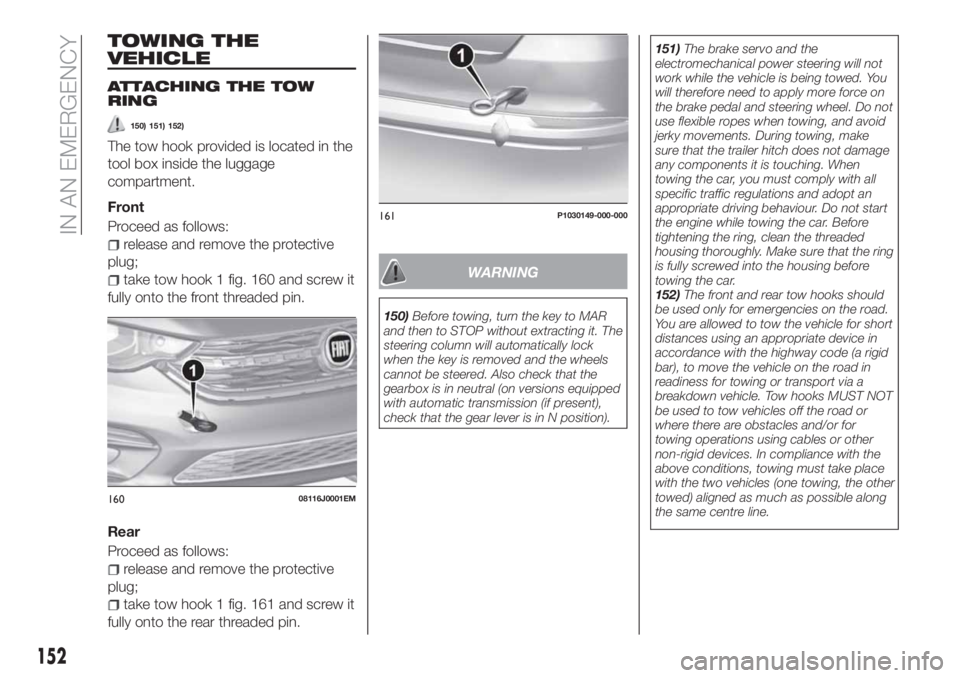
TOWING THE
VEHICLE
ATTACHING THE TOW
RING
150) 151) 152)
The tow hook provided is located in the
tool box inside the luggage
compartment.
Front
Proceed as follows:
release and remove the protective
plug;
take tow hook 1 fig. 160 and screw it
fully onto the front threaded pin.
Rear
Proceed as follows:
release and remove the protective
plug;
take tow hook 1 fig. 161 and screw it
fully onto the rear threaded pin.
WARNING
150)Before towing, turn the key to MAR
and then to STOP without extracting it. The
steering column will automatically lock
when the key is removed and the wheels
cannot be steered. Also check that the
gearbox is in neutral (on versions equipped
with automatic transmission (if present),
check that the gear lever is in N position).151)The brake servo and the
electromechanical power steering will not
work while the vehicle is being towed. You
will therefore need to apply more force on
the brake pedal and steering wheel. Do not
use flexible ropes when towing, and avoid
jerky movements. During towing, make
sure that the trailer hitch does not damage
any components it is touching. When
towing the car, you must comply with all
specific traffic regulations and adopt an
appropriate driving behaviour. Do not start
the engine while towing the car. Before
tightening the ring, clean the threaded
housing thoroughly. Make sure that the ring
is fully screwed into the housing before
towing the car.
152)The front and rear tow hooks should
be used only for emergencies on the road.
You are allowed to tow the vehicle for short
distances using an appropriate device in
accordance with the highway code (a rigid
bar), to move the vehicle on the road in
readiness for towing or transport via a
breakdown vehicle. Tow hooks MUST NOT
be used to tow vehicles off the road or
where there are obstacles and/or for
towing operations using cables or other
non-rigid devices. In compliance with the
above conditions, towing must take place
with the two vehicles (one towing, the other
towed) aligned as much as possible along
the same centre line.
16008116J0001EM
161P1030149-000-000
152
IN AN EMERGENCY
Page 155 of 252
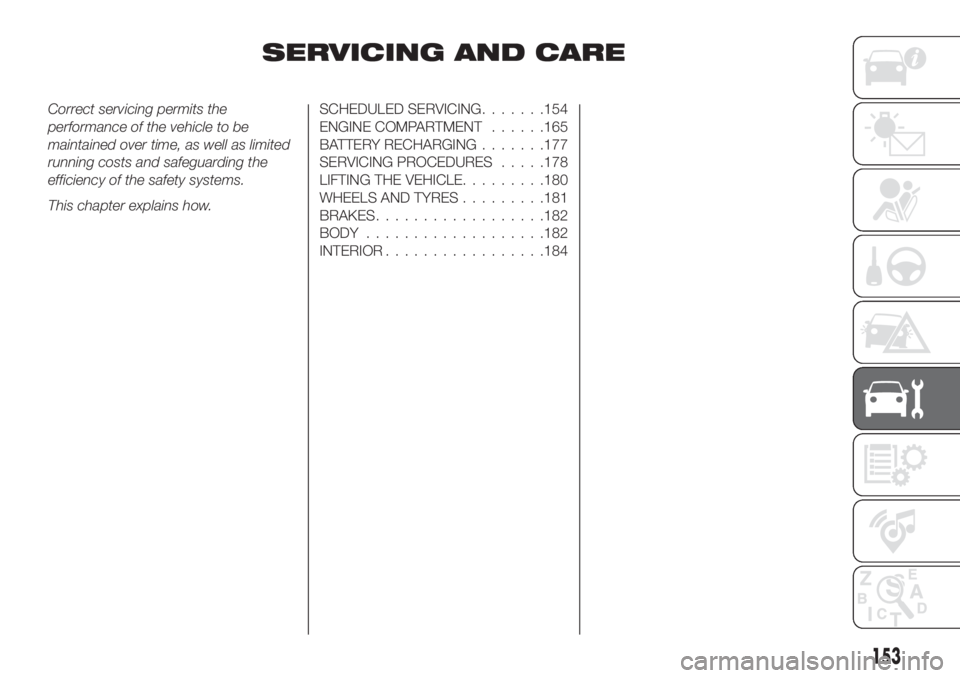
SERVICING AND CARE
Correct servicing permits the
performance of the vehicle to be
maintained over time, as well as limited
running costs and safeguarding the
efficiency of the safety systems.
This chapter explains how.SCHEDULED SERVICING.......154
ENGINE COMPARTMENT......165
BATTERY RECHARGING.......177
SERVICING PROCEDURES.....178
LIFTING THE VEHICLE.........180
WHEELS AND TYRES.........181
BRAKES..................182
BODY...................182
INTERIOR.................184
153
Page 157 of 252
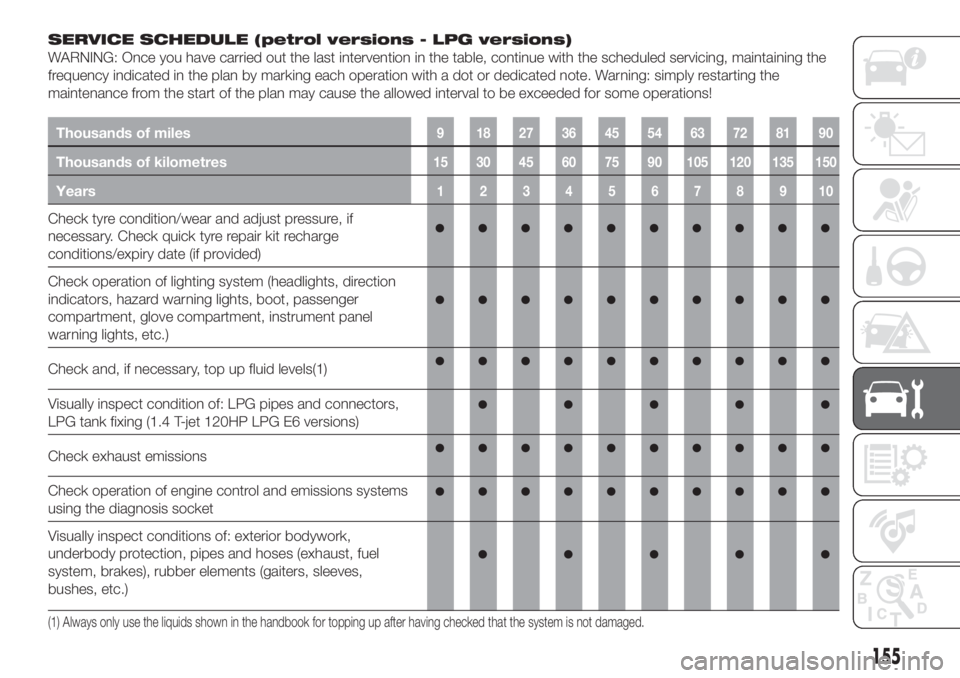
SERVICE SCHEDULE (petrol versions - LPG versions)
WARNING: Once you have carried out the last intervention in the table, continue with the scheduled servicing, maintaining the
frequency indicated in the plan by marking each operation with a dot or dedicated note. Warning: simply restarting the
maintenance from the start of the plan may cause the allowed interval to be exceeded for some operations!
Thousands of miles9 182736455463728190
Thousands of kilometres15 30 45 60 75 90 105 120 135 150
Years12345678910
Check tyre condition/wear and adjust pressure, if
necessary. Check quick tyre repair kit recharge
conditions/expiry date (if provided)
Check operation of lighting system (headlights, direction
indicators, hazard warning lights, boot, passenger
compartment, glove compartment, instrument panel
warning lights, etc.)
Check and, if necessary, top up fluid levels(1)
Visually inspect condition of: LPG pipes and connectors,
LPG tank fixing (1.4 T-jet 120HP LPG E6 versions)
Check exhaust emissions
Check operation of engine control and emissions systems
using the diagnosis socket
Visually inspect conditions of: exterior bodywork,
underbody protection, pipes and hoses (exhaust, fuel
system, brakes), rubber elements (gaiters, sleeves,
bushes, etc.)
(1) Always only use the liquids shown in the handbook for topping up after having checked that the system is not damaged.
155
Page 159 of 252
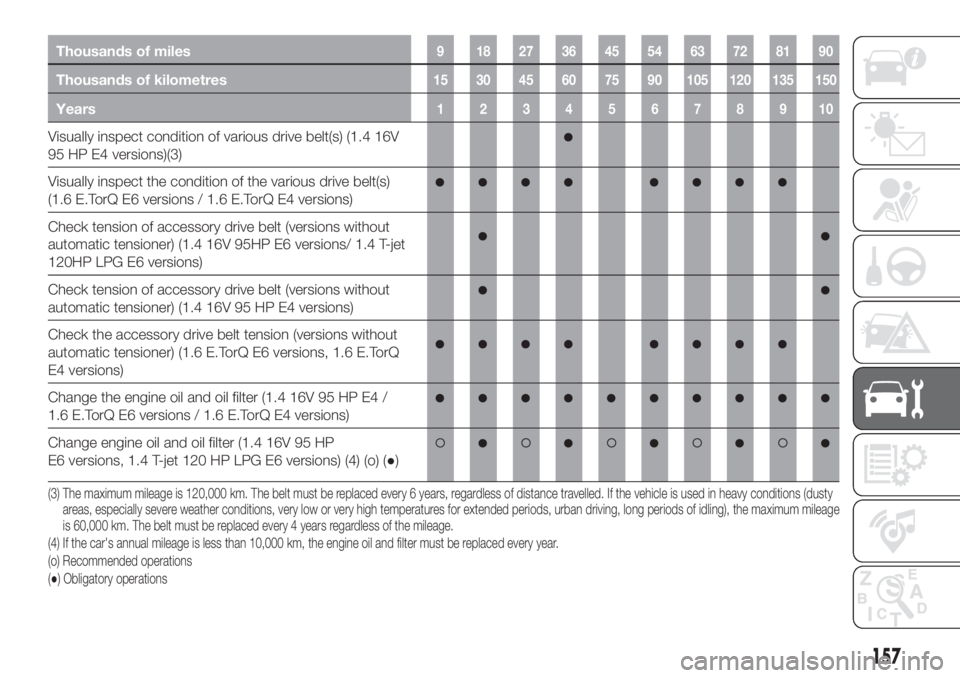
Thousands of miles9 182736455463728190
Thousands of kilometres15 30 45 60 75 90 105 120 135 150
Years12345678910
Visually inspect condition of various drive belt(s) (1.4 16V
95 HP E4 versions)(3)
Visually inspect the condition of the various drive belt(s)
(1.6 E.TorQ E6 versions / 1.6 E.TorQ E4 versions)
Check tension of accessory drive belt (versions without
automatic tensioner) (1.4 16V 95HP E6 versions/ 1.4 T-jet
120HP LPG E6 versions)
Check tension of accessory drive belt (versions without
automatic tensioner) (1.4 16V 95 HP E4 versions)
Check the accessory drive belt tension (versions without
automatic tensioner) (1.6 E.TorQ E6 versions, 1.6 E.TorQ
E4 versions)
Change the engine oil and oil filter (1.4 16V 95 HP E4 /
1.6 E.TorQ E6 versions / 1.6 E.TorQ E4 versions)
Change engine oil and oil filter (1.4 16V 95 HP
E6 versions, 1.4 T-jet 120 HP LPG E6 versions) (4) (o) (●)
(3) The maximum mileage is 120,000 km. The belt must be replaced every 6 years, regardless of distance travelled. If the vehicle is used in heavy conditions (dusty
areas, especially severe weather conditions, very low or very high temperatures for extended periods, urban driving, long periods of idling), the maximum mileage
is 60,000 km. The belt must be replaced every 4 years regardless of the mileage.
(4) If the car's annual mileage is less than 10,000 km, the engine oil and filter must be replaced every year.
(o) Recommended operations
(●) Obligatory operations
157
Page 160 of 252
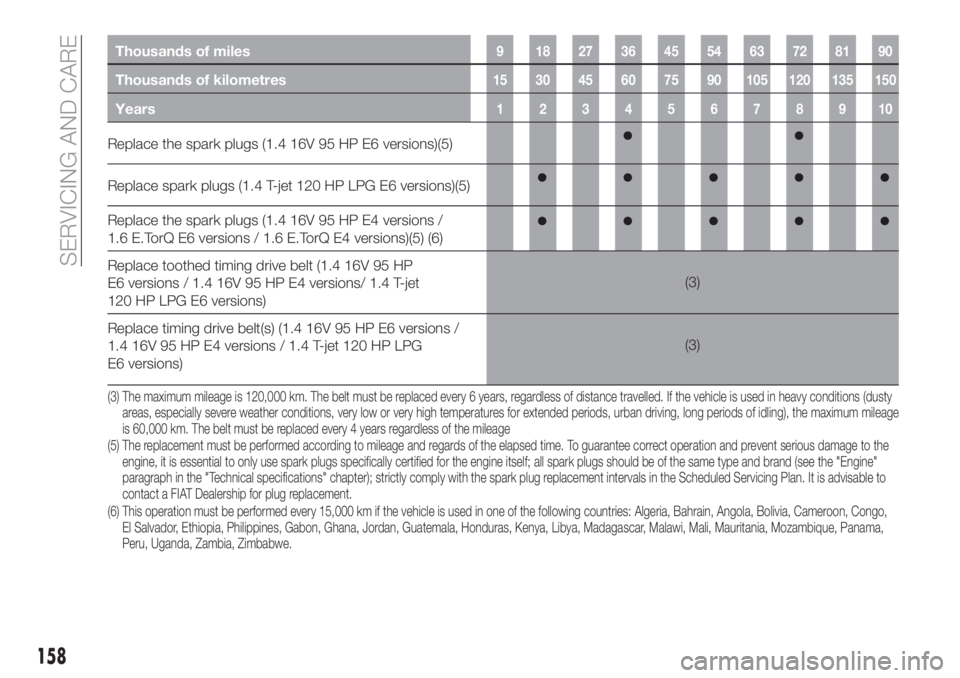
Thousands of miles9 182736455463728190
Thousands of kilometres15 30 45 60 75 90 105 120 135 150
Years12345678910
Replace the spark plugs (1.4 16V 95 HP E6 versions)(5)
Replace spark plugs (1.4 T-jet 120 HP LPG E6 versions)(5)
Replace the spark plugs (1.4 16V 95 HP E4 versions /
1.6 E.TorQ E6 versions / 1.6 E.TorQ E4 versions)(5) (6)
Replace toothed timing drive belt (1.4 16V 95 HP
E6 versions / 1.4 16V 95 HP E4 versions/ 1.4 T-jet
120 HP LPG E6 versions)(3)
Replace timing drive belt(s) (1.4 16V 95 HP E6 versions /
1.4 16V 95 HP E4 versions / 1.4 T-jet 120 HP LPG
E6 versions)(3)
(5) The replacement must be performed according to mileage and regards of the elapsed time. To guarantee correct operation and prevent serious damageto the
engine, it is essential to only use spark plugs specifically certified for the engine itself; all spark plugs should be of the same type and brand (see the "Engine"
paragraph in the "Technical specifications" chapter); strictly comply with the spark plug replacement intervals in the Scheduled Servicing Plan. It is advisable to
contact a FIAT Dealership for plug replacement.
(6) This operation must be performed every 15,000 km if the vehicle is used in one of the following countries: Algeria, Bahrain, Angola, Bolivia, Cameroon, Congo,
El Salvador, Ethiopia, Philippines, Gabon, Ghana, Jordan, Guatemala, Honduras, Kenya, Libya, Madagascar, Malawi, Mali, Mauritania, Mozambique,Panama,
Peru, Uganda, Zambia, Zimbabwe. (3) The maximum mileage is 120,000 km. The belt must be replaced every 6 years, regardless of distance travelled. If the vehicle is used in heavy conditions (dusty
areas, especially severe weather conditions, very low or very high temperatures for extended periods, urban driving, long periods of idling), the maximum mileage
is 60,000 km. The belt must be replaced every 4 years regardless of the mileage
158
SERVICING AND CARE
Page 162 of 252
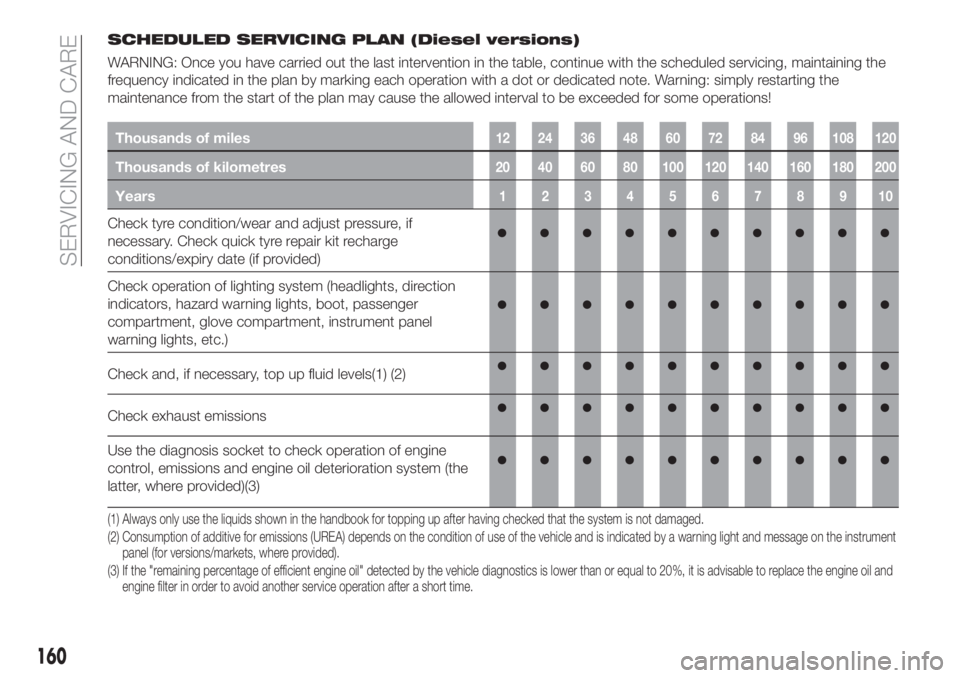
SCHEDULED SERVICING PLAN (Diesel versions)
WARNING: Once you have carried out the last intervention in the table, continue with the scheduled servicing, maintaining the
frequency indicated in the plan by marking each operation with a dot or dedicated note. Warning: simply restarting the
maintenance from the start of the plan may cause the allowed interval to be exceeded for some operations!
Thousands of miles12 24 36 48 60 72 84 96 108 120
Thousands of kilometres20 40 60 80 100 120 140 160 180 200
Years12345678910
Check tyre condition/wear and adjust pressure, if
necessary. Check quick tyre repair kit recharge
conditions/expiry date (if provided)
Check operation of lighting system (headlights, direction
indicators, hazard warning lights, boot, passenger
compartment, glove compartment, instrument panel
warning lights, etc.)
Check and, if necessary, top up fluid levels(1) (2)
Check exhaust emissions
Use the diagnosis socket to check operation of engine
control, emissions and engine oil deterioration system (the
latter, where provided)(3)
(1) Always only use the liquids shown in the handbook for topping up after having checked that the system is not damaged.
(2) Consumption of additive for emissions (UREA) depends on the condition of use of the vehicle and is indicated by a warning light and message on the instrument
panel (for versions/markets, where provided).
(3) If the "remaining percentage of efficient engine oil" detected by the vehicle diagnostics is lower than or equal to 20%, it is advisable to replace the engine oil and
engine filter in order to avoid another service operation after a short time.
160
SERVICING AND CARE
Page 164 of 252
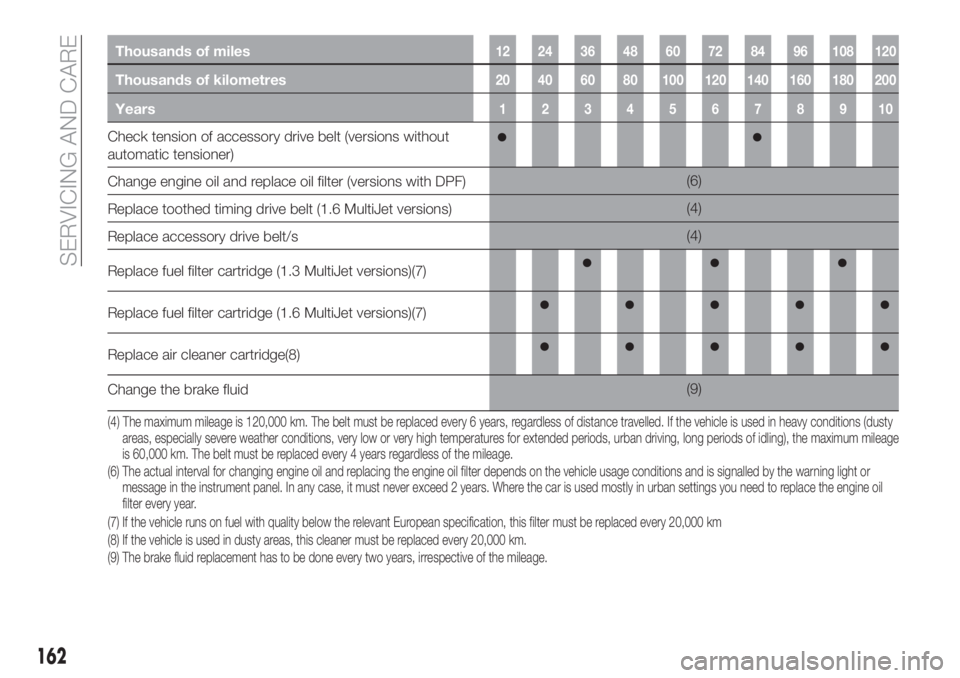
Thousands of miles12 24 36 48 60 72 84 96 108 120
Thousands of kilometres20 40 60 80 100 120 140 160 180 200
Years12345678910
Check tension of accessory drive belt (versions without
automatic tensioner)
Change engine oil and replace oil filter (versions with DPF)(6)
Replace toothed timing drive belt (1.6 MultiJet versions)(4)
Replace accessory drive belt/s(4)
Replace fuel filter cartridge (1.3 MultiJet versions)(7)
Replace fuel filter cartridge (1.6 MultiJet versions)(7)
Replace air cleaner cartridge(8)
Change the brake fluid(9)
(6) The actual interval for changing engine oil and replacing the engine oil filter depends on the vehicle usage conditions and is signalled by the warning light or
message in the instrument panel. In any case, it must never exceed 2 years. Where the car is used mostly in urban settings you need to replace the engine oil
filter every year. (4 ) The maximum mileage is 120,000 km. The belt must be replaced every 6 years, regardless of distance travelled. If the vehicle is used in heavy conditions (dusty
areas, especially severe weather conditions, very low or very high temperatures for extended periods, urban driving, long periods of idling), the maximum mileage
is 60,000 km. The belt must be replaced every 4 years regardless of the mileage.
(7) If the vehicle runs on fuel with quality below the relevant European specification, this filter must be replaced every 20,000 km
(8) If the vehicle is used in dusty areas, this cleaner must be replaced every 20,000 km.
(9) The brake fluid replacement has to be done every two years, irrespective of the mileage.
162
SERVICING AND CARE
Page 166 of 252
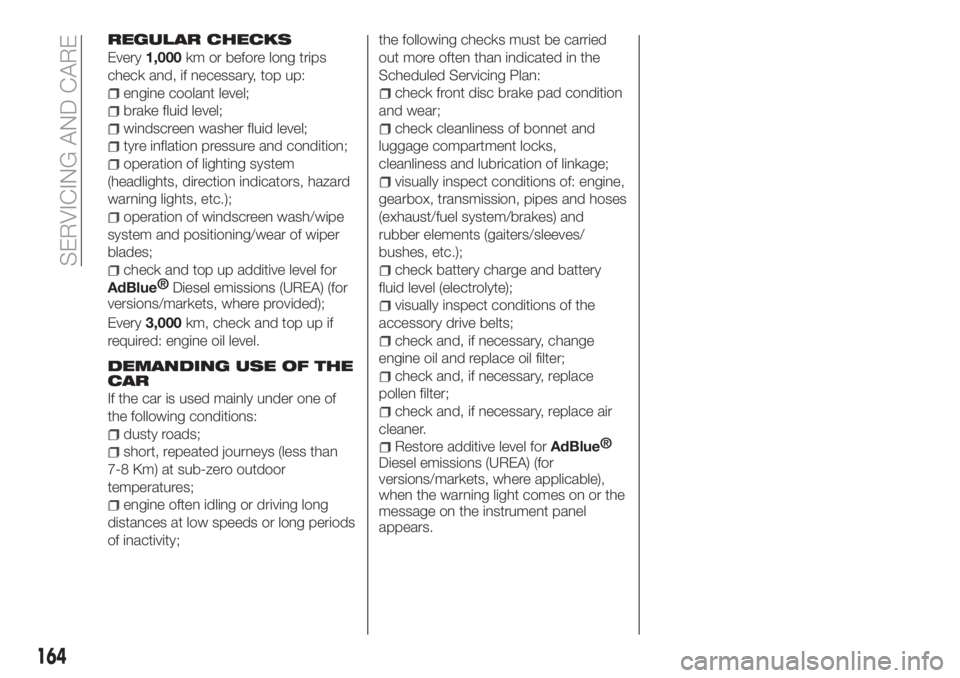
REGULAR CHECKS
Every1,000km or before long trips
check and, if necessary, top up:
engine coolant level;
brake fluid level;
windscreen washer fluid level;
tyre inflation pressure and condition;
operation of lighting system
(headlights, direction indicators, hazard
warning lights, etc.);
operation of windscreen wash/wipe
system and positioning/wear of wiper
blades;
check and top up additive level for
AdBlue®
Diesel emissions (UREA) (for
versions/markets, where provided);
Every3,000km, check and top up if
required: engine oil level.
DEMANDING USE OF THE
CAR
If the car is used mainly under one of
the following conditions:
dusty roads;
short, repeated journeys (less than
7-8 Km) at sub-zero outdoor
temperatures;
engine often idling or driving long
distances at low speeds or long periods
of inactivity;the following checks must be carried
out more often than indicated in the
Scheduled Servicing Plan:
check front disc brake pad condition
and wear;
check cleanliness of bonnet and
luggage compartment locks,
cleanliness and lubrication of linkage;
visually inspect conditions of: engine,
gearbox, transmission, pipes and hoses
(exhaust/fuel system/brakes) and
rubber elements (gaiters/sleeves/
bushes, etc.);
check battery charge and battery
fluid level (electrolyte);
visually inspect conditions of the
accessory drive belts;
check and, if necessary, change
engine oil and replace oil filter;
check and, if necessary, replace
pollen filter;
check and, if necessary, replace air
cleaner.
Restore additive level forAdBlue®
Diesel emissions (UREA) (for
versions/markets, where applicable),
when the warning light comes on or the
message on the instrument panel
appears.
164
SERVICING AND CARE
Page 167 of 252
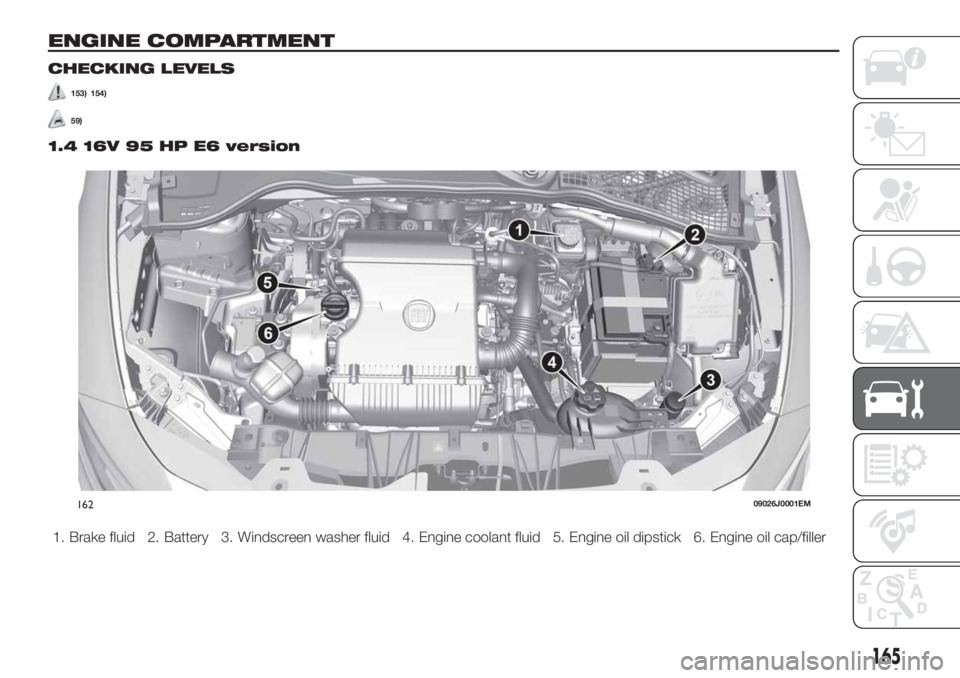
ENGINE COMPARTMENT
CHECKING LEVELS
153) 154)
59)
1.4 16V 95 HP E6 version
1. Brake fluid 2. Battery 3. Windscreen washer fluid 4. Engine coolant fluid 5. Engine oil dipstick 6. Engine oil cap/filler
16209026J0001EM
165
Page 168 of 252
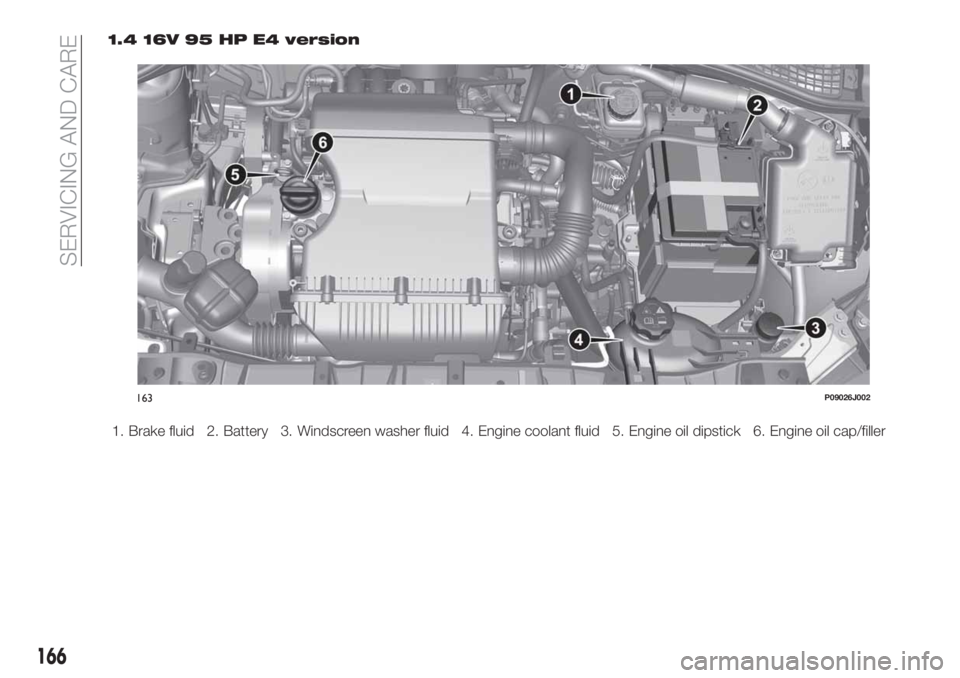
1.4 16V 95 HP E4 version
1. Brake fluid 2. Battery 3. Windscreen washer fluid 4. Engine coolant fluid 5. Engine oil dipstick 6. Engine oil cap/filler
163P09026J002
166
SERVICING AND CARE